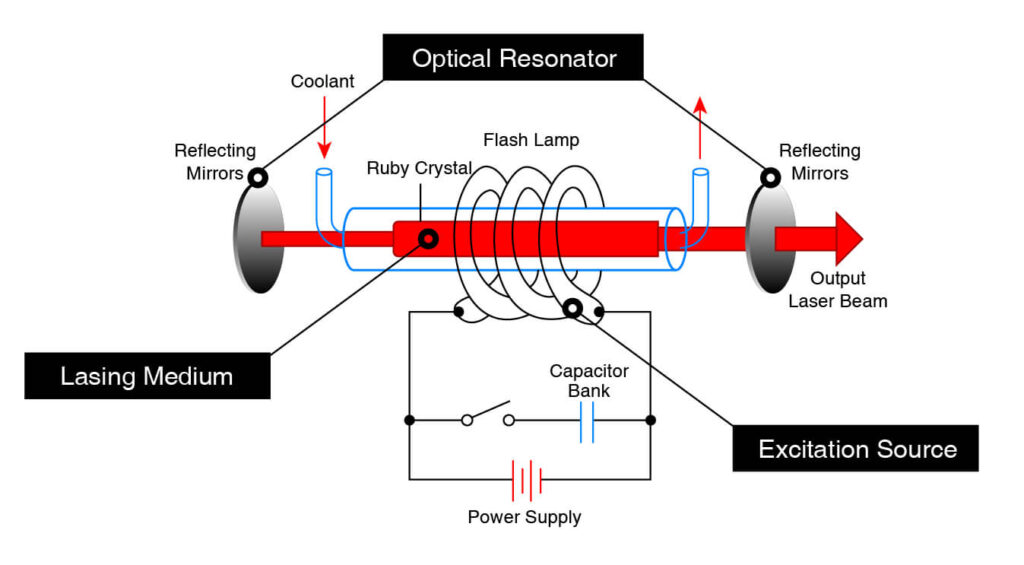What is Laser
“Laser,” which stands for “Light Amplification by Stimulated Emission of Radiation.” It refers to the amplification of light produced by stimulating atoms, causing electrons to transition and emit radiation, resulting in a coherent beam of enhanced photons. Unlike ordinary light, the radiation emitted by a laser has the same phase, frequency, and direction of vibration.
Who invented the Laser
In May 1960, Theodore Maiman successfully built the world’s first operational ruby laser with a wavelength of 0.6943 microns. He coated the ends of a 1 cm diameter, 2 cm long ruby rod with silver mirrors, leaving a small hole on one end to allow the laser to emit. He placed the ruby crystal inside a helical xenon flashlamp and then positioned them within a highly reflective cylindrical cavity, producing a coherent pulsed laser beam.
However, the theoretical groundwork for the laser was laid by several scientists, most notably Albert Einstein, who introduced the concept of stimulated emission—the fundamental principle behind laser operation. Other key contributors include Charles Townes and Arthur Schawlow, who developed the maser (a microwave precursor to the laser) and wrote the first detailed proposal for a visible-light laser.
So while Maiman built the first laser, it was the result of many scientific advances over several decades.
First Laser
The world’s first laser was a ruby laser, and it was only about the size of a hand. Its basic structure included the three essential components of laser: the lasing medium, the excitation source, and the optical resonator. In the ruby laser, the lasing medium was a ruby crystal, the excitation source was a flash lamp, and the resonator consisted of two mirrors at both ends of the ruby crystal. The working principle of the ruby laser is that the light emitted by the flash lamp excited a population inversion in the particles within the ruby crystal, causing the crystal rod to generate laser light, which was amplified by the resonator to produce a laser beam.
Laser invention history & When was the laser made
1917
Einstein Proposed the Theory of Stimulated Emission
Einstein hypothesized that atoms could emit photons through stimulation, leading to the amplification of light.
1951
Verification of the Theory of Stimulated Emission
American physicists Edward Purcell and Robert Pound successfully verified Einstein’s theory by achieving population inversion using a traditional light source for pumping in their experiment. They obtained stimulated emission at a frequency of 50 kHz, confirming the theory.
1954
Development of the Maser
Charles Townes and Arthur Schawlow invented the maser (Microwave Amplification by Stimulated Emission of Radiation) at Columbia University. This device emitted microwaves instead of visible light.
Nikolay Basov and Alexander Prokhorov in the Soviet Union also independently developed the maser, contributing to its theoretical foundation.
1958
First Proposal for a Laser
Townes and Schawlow extended the principles of the maser to the optical range (visible light) and published a paper in 1958 detailing how to construct a laser. This was the first formal proposal of a laser, though it remained theoretical at the time.
1960
Birth of the First Laser
On May 16, 1960, Theodore H. Maiman successfully demonstrated the world’s first laser at Hughes Research Laboratories in California. He used a synthetic ruby crystal as the gain medium, creating the first functional laser, which emitted red light.
1960s
Development of Various Laser Types
Gas Laser: In 1960, Ali Javan, along with William Bennett and Donald Herriott, developed the helium-neon (He-Ne) laser, which emitted continuous red light and was more stable than ruby lasers.
Semiconductor lasers: By the early 1960s, scientists like **Robert N. Hall** developed semiconductor lasers, which use diode materials to produce laser light and are crucial in modern electronics, such as CD and DVD players.
Dye lasers and fiber lasers followed shortly after, expanding the range of possible applications.
1964 & 1981
Nobel Prize Recognition
In 1964, the Nobel Prize in Physics was awarded to Charles Townes, Nikolay Basov, and Alexander Prokhorov for their contributions to the development of the maser and laser.
In 1981, Arthur Schawlow was awarded the Nobel Prize in Physics for his contributions to laser technology.
1970s-Present
Applications of Lasers
Telecommunications: Optical fiber communications revolutionized data transmission in the 1970s.
Medicine: Lasers are used in surgery, particularly in eye procedures like LASIK, and in dermatology.
Industry: Cutting, welding, and material processing industries adopted lasers due to their precision.
Science: Lasers enabled advancements in spectroscopy and holography.
Consumer Electronics: Laser technology became a foundation of devices like barcode scanners, CD/DVD players, and laser printers.
1980s
Modern Laser Technology
Since the 1980s, ultrafast lasers, high-power lasers, and femtosecond lasers (which emit pulses lasting only a few quadrillionths of a second) have been developed, driving progress in fields such as microscopy, precision surgery, and material science.
1997
Nobel Prize for Laser Cooling Technology
Laser cooling technology, which uses lasers to cool atoms to near absolute zero, helped advance research in quantum mechanics.
As a groundbreaking technology, laser has found widespread application in various fields since its inception. From early scientific experiments to its critical role today in communications, medicine, industry, and consumer electronics, the impact of lasers is undeniable. As technology continues to advance, the performance and application areas of lasers keep expanding, offering even more possibilities for future scientific exploration, innovation, and societal progress. The history of lasers is not only a story of technological evolution but also a testament to humanity’s relentless pursuit of pushing the boundaries of physics, inspiring us with boundless anticipation for future technologies.


